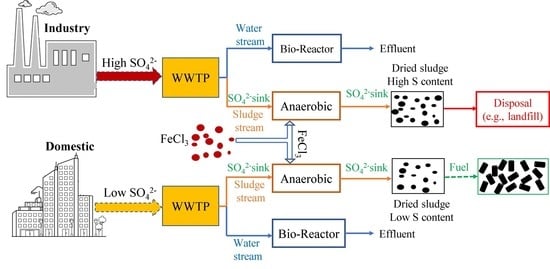Fate of Sulfate in Municipal Wastewater Treatment Plants and Its Effect on Sludge Recycling as a Fuel Source
Abstract
Share and Cite
Ho, Q.N.; Anam, G.B.; Kim, J.; Park, S.; Lee, T.-U.; Jeon, J.-Y.; Choi, Y.-Y.; Ahn, Y.-H.; Lee, B.J. Fate of Sulfate in Municipal Wastewater Treatment Plants and Its Effect on Sludge Recycling as a Fuel Source. Sustainability 2023, 15, 311. https://doi.org/10.3390/su15010311
Ho QN, Anam GB, Kim J, Park S, Lee T-U, Jeon J-Y, Choi Y-Y, Ahn Y-H, Lee BJ. Fate of Sulfate in Municipal Wastewater Treatment Plants and Its Effect on Sludge Recycling as a Fuel Source. Sustainability. 2023; 15(1):311. https://doi.org/10.3390/su15010311
Chicago/Turabian StyleHo, Que Nguyen, Giridhar Babu Anam, Jaein Kim, Somin Park, Tae-U Lee, Jae-Young Jeon, Yun-Young Choi, Young-Ho Ahn, and Byung Joon Lee. 2023. "Fate of Sulfate in Municipal Wastewater Treatment Plants and Its Effect on Sludge Recycling as a Fuel Source" Sustainability 15, no. 1: 311. https://doi.org/10.3390/su15010311
APA StyleHo, Q. N., Anam, G. B., Kim, J., Park, S., Lee, T.-U., Jeon, J.-Y., Choi, Y.-Y., Ahn, Y.-H., & Lee, B. J. (2023). Fate of Sulfate in Municipal Wastewater Treatment Plants and Its Effect on Sludge Recycling as a Fuel Source. Sustainability, 15(1), 311. https://doi.org/10.3390/su15010311






